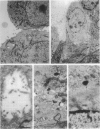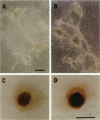Abstract
A line of hepatic endoderm cells, hepatoblast cell line 3 (HBC-3), was derived from the liver diverticulum of the mouse on day 9.5 of gestation by culture on a mitomycin C treated STON+ feeder layer in a hepatoblast culture medium consisting of Dulbecco's modified Eagle's medium, nonessential amino acids, fetal calf serum, and beta-mercaptoethanol. This line, HBC-3, stains positively for alpha-fetoprotein, albumin, and cytokeratin 14 (CK-14), protein markers expressed by the embryonic liver diverticulum, indicating that HBC-3 cells retain an undifferentiated hepatoblast phenotype. HBC-3 cells acquire hepatocyte-like ultrastructural characteristics, including bile canaliculi, peroxisomes, and glycogen granules, when maintained in culture for 3 weeks without passage. Treatment with dimethylsulfoxide or sodium butyrate induces a rapid hepatocytic differentiation. The cells cease to express alpha-fetoprotein and CK-14, maintain albumin expression, and become positive for glucose-6-phosphatase activity (a profile consistent with differentiation along the hepatocyte lineage). On Matrigel, HBC-3 cells form elaborate ductular structures, which are positive for gamma-glutamyl transpeptidase and CK-14 and CK-19 and do not express detectable amounts of albumin, a phenotypic change consistent with differentiation along the bile ductular lineage. Thus, HBC-3 cells behave in culture as bipotential hepatoblasts and provide a model system to identify factors that regulate bipotential differentiation in the liver.
Full text
PDF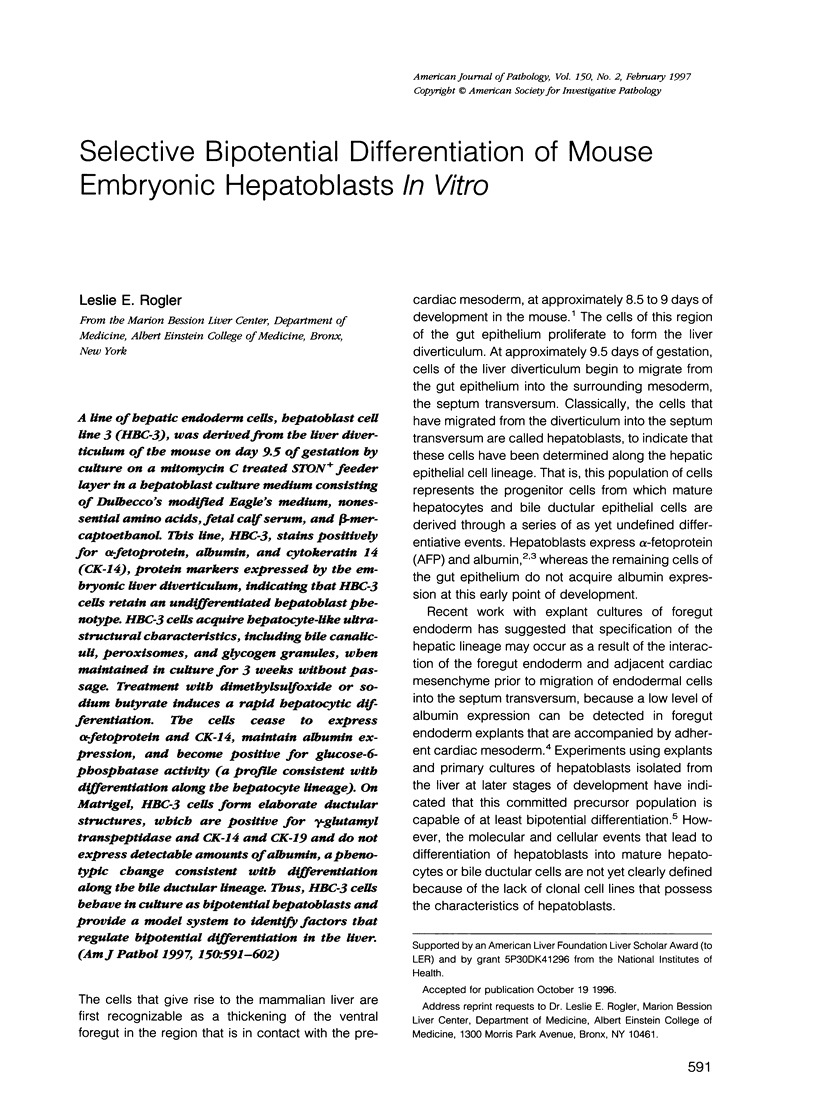
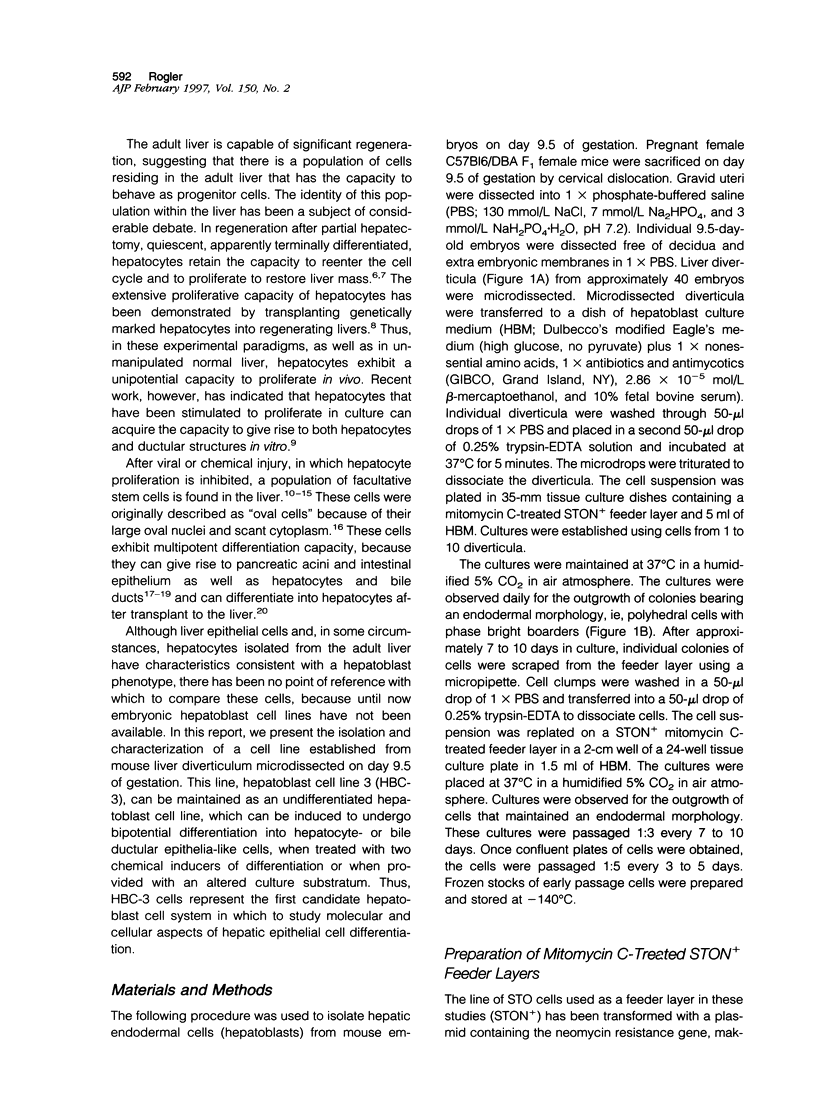
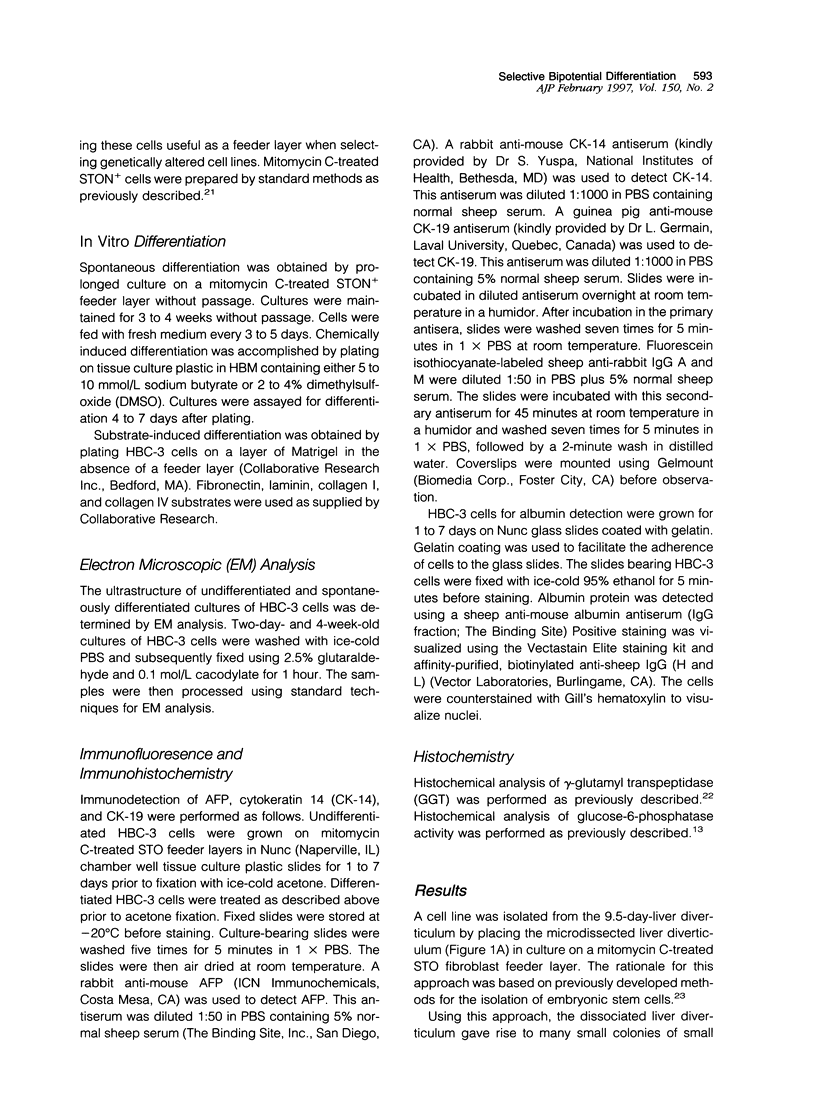
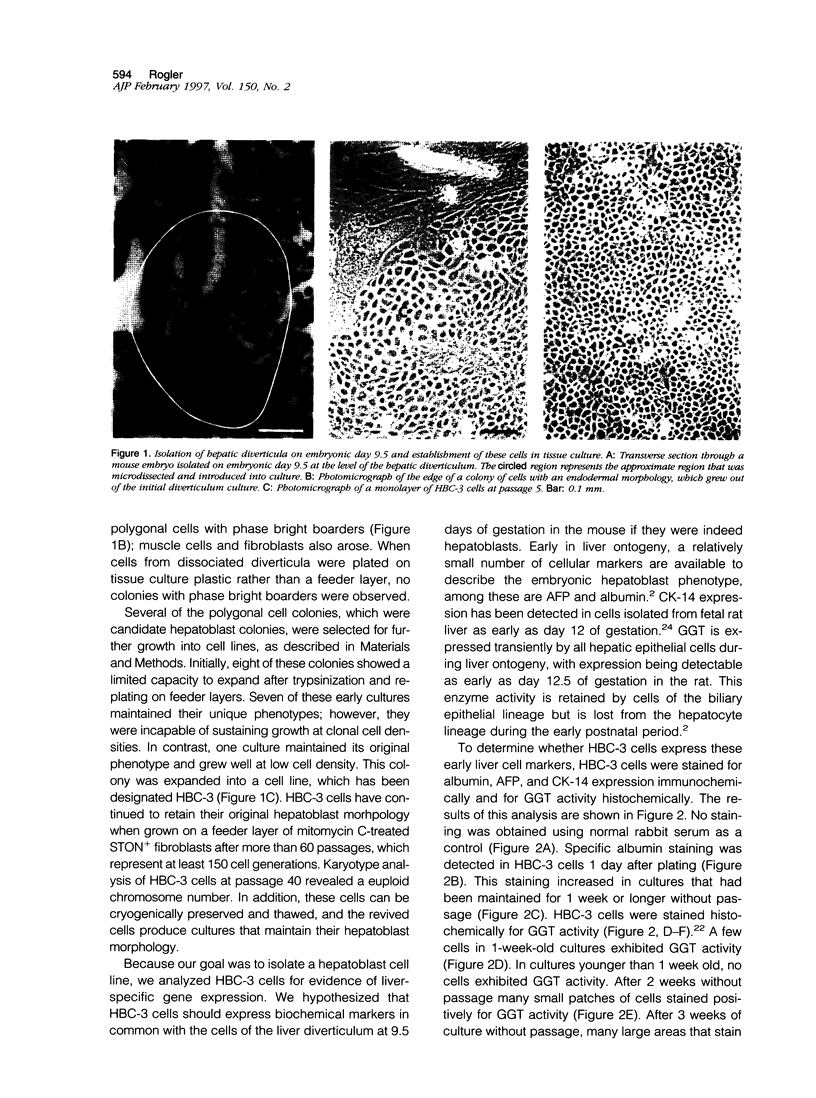
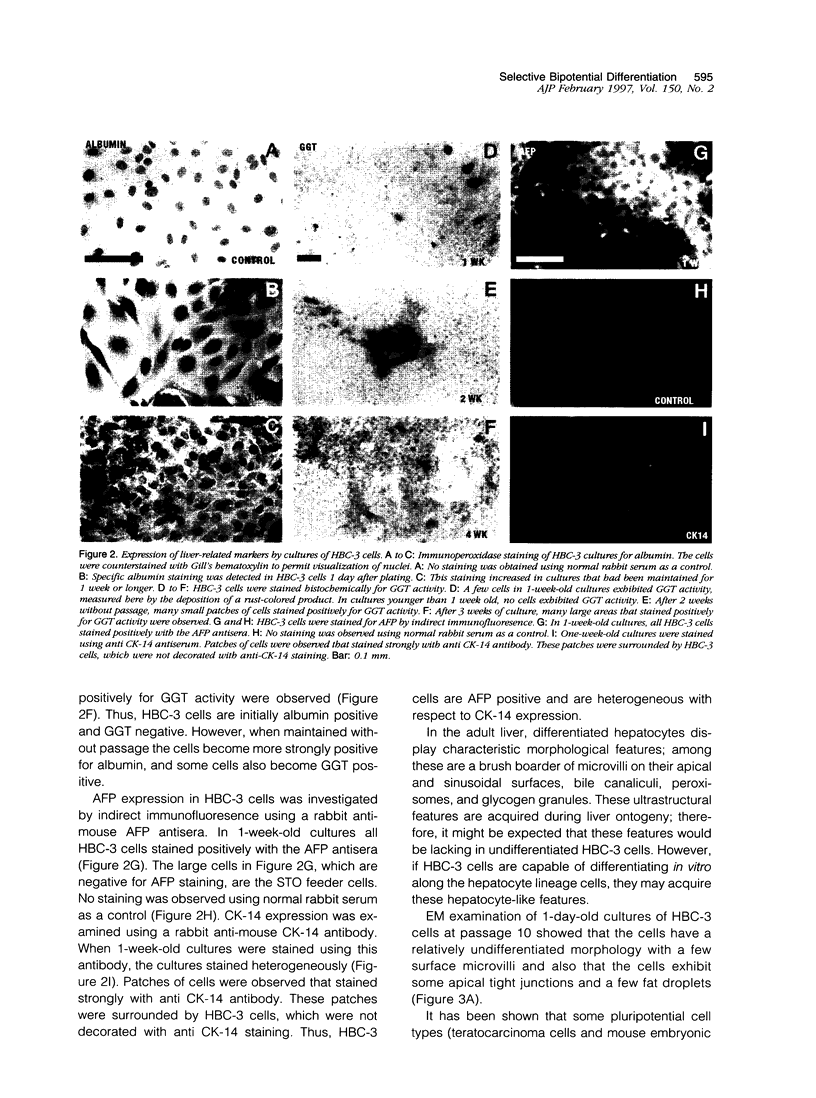
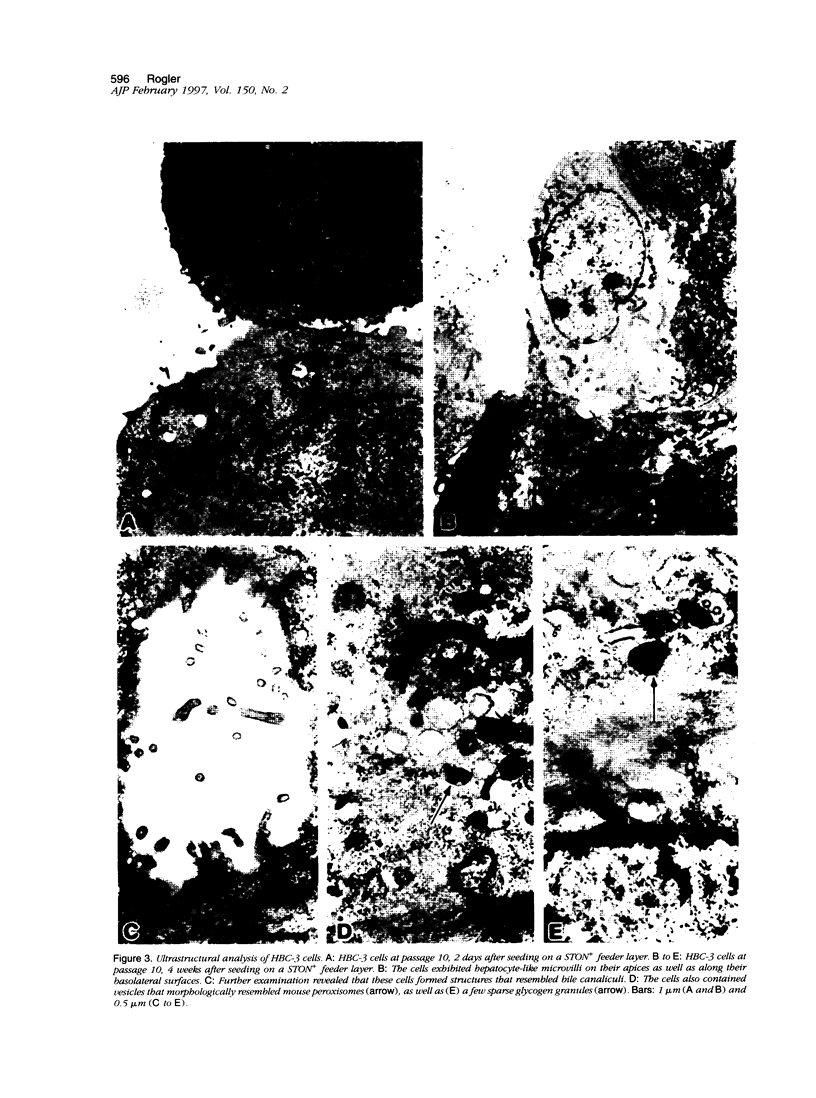
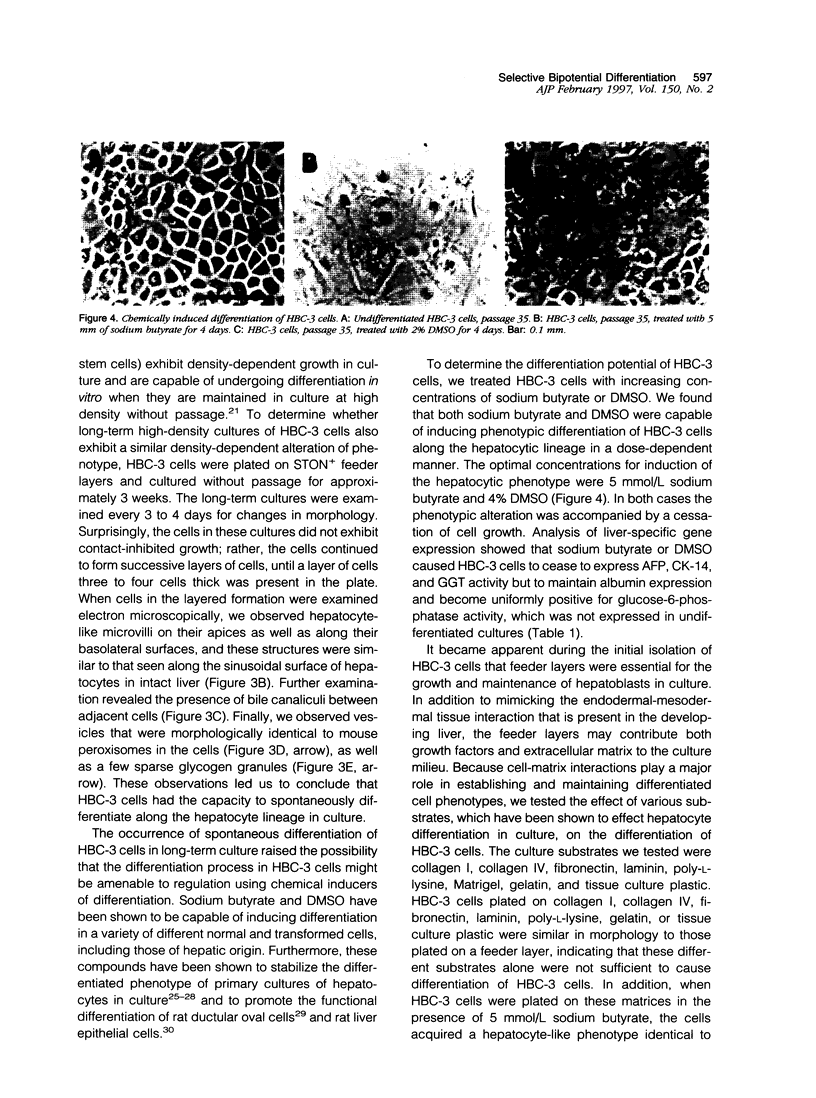
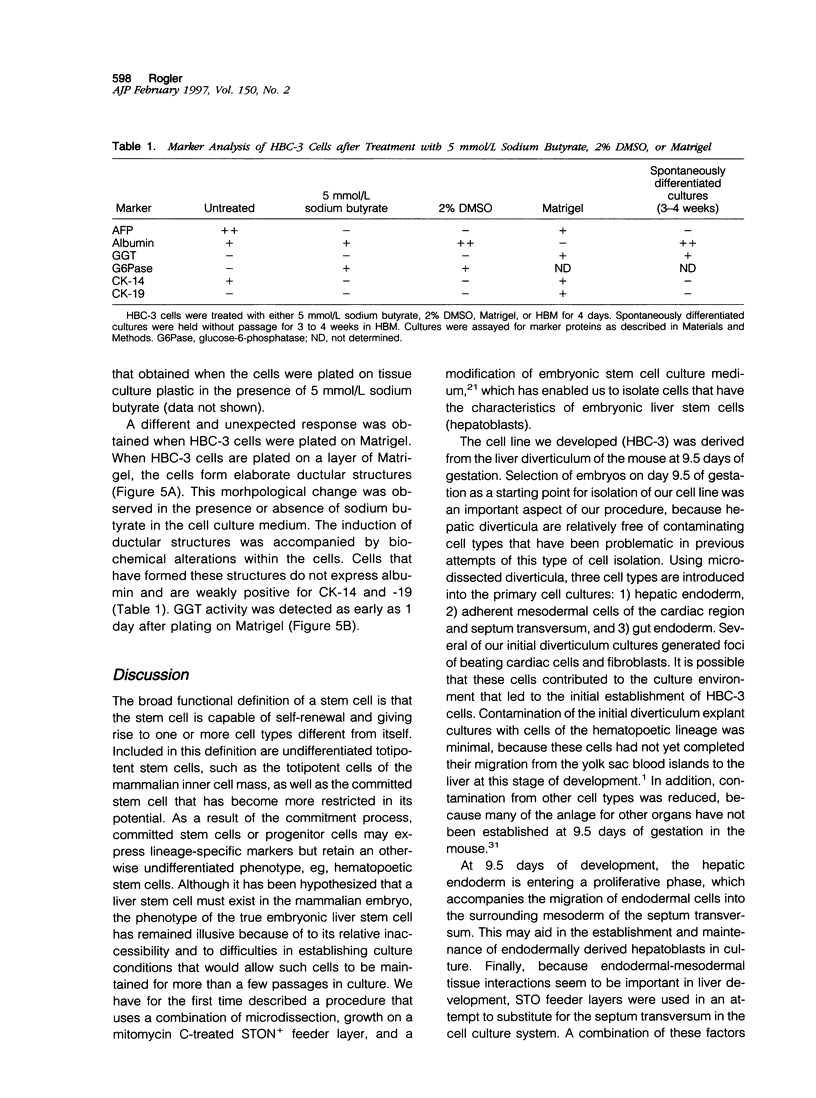
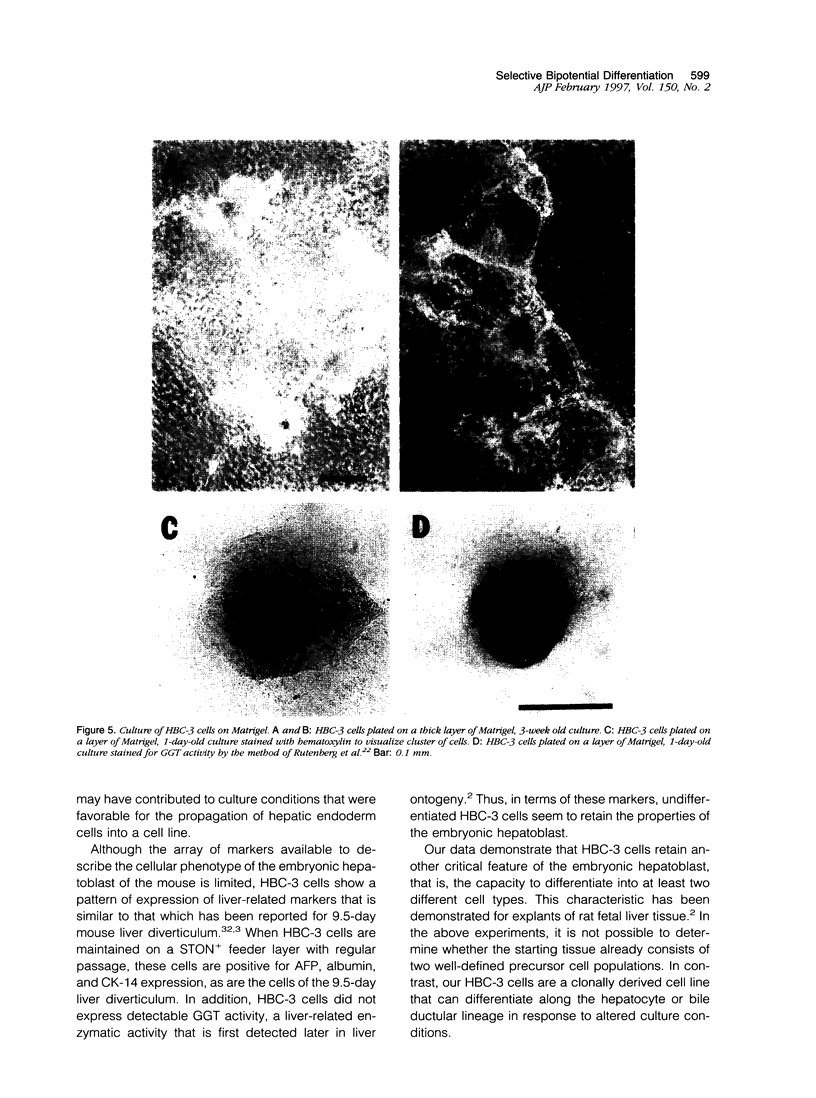
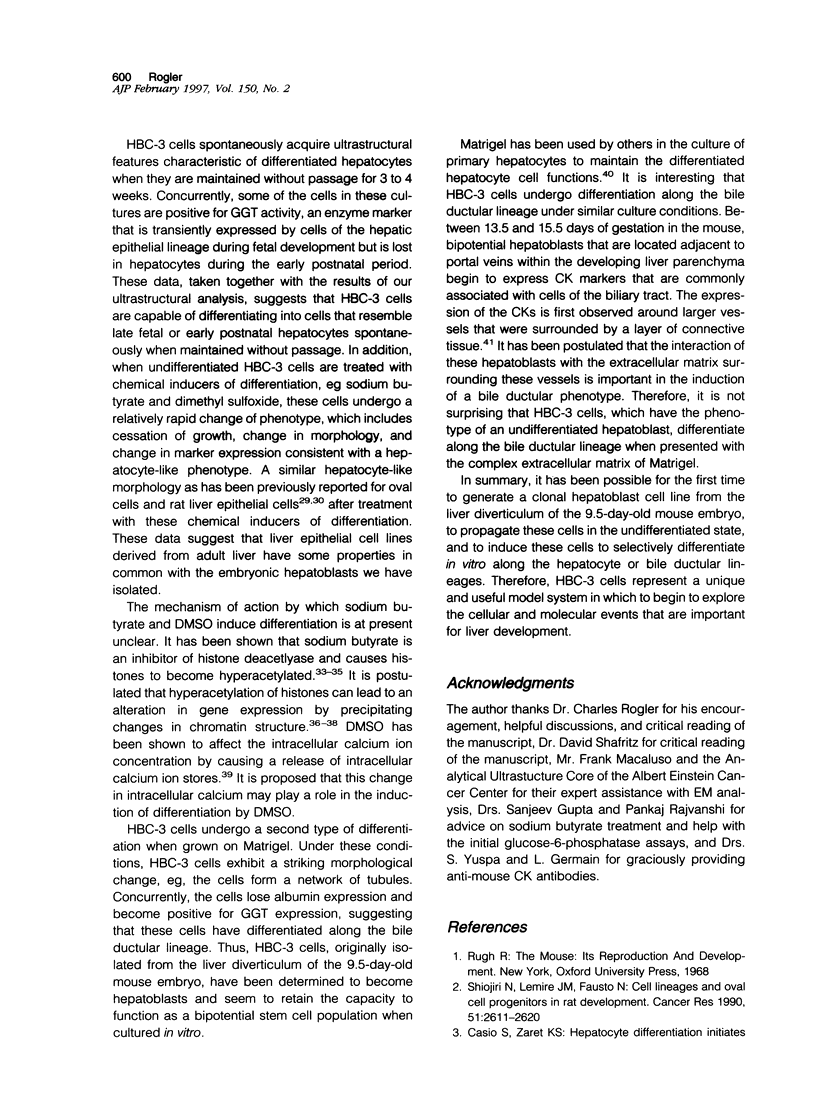

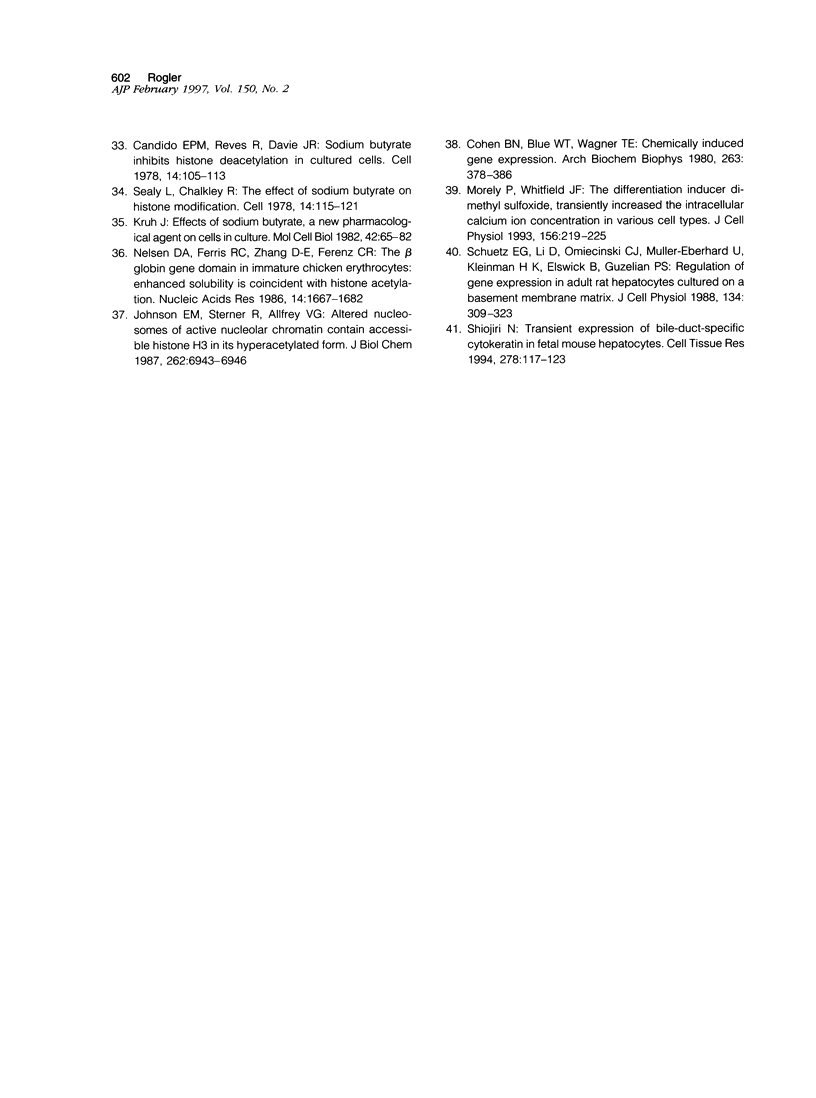
Images in this article
Selected References
These references are in PubMed. This may not be the complete list of references from this article.
- Block G. D., Locker J., Bowen W. C., Petersen B. E., Katyal S., Strom S. C., Riley T., Howard T. A., Michalopoulos G. K. Population expansion, clonal growth, and specific differentiation patterns in primary cultures of hepatocytes induced by HGF/SF, EGF and TGF alpha in a chemically defined (HGM) medium. J Cell Biol. 1996 Mar;132(6):1133–1149. doi: 10.1083/jcb.132.6.1133. [DOI] [PMC free article] [PubMed] [Google Scholar]
- Blouin M. J., Lamy I., Loranger A., Noël M., Corlu A., Guguen-Guillouzo C., Marceau N. Specialization switch in differentiating embryonic rat liver progenitor cells in response to sodium butyrate. Exp Cell Res. 1995 Mar;217(1):22–30. doi: 10.1006/excr.1995.1059. [DOI] [PubMed] [Google Scholar]
- Blouin R., Blouin M. J., Royal I., Grenier A., Roop D. R., Loranger A., Marceau N. Cytokeratin 14 expression in rat liver cells in culture and localization in vivo. Differentiation. 1992 Dec;52(1):45–54. doi: 10.1111/j.1432-0436.1992.tb00498.x. [DOI] [PubMed] [Google Scholar]
- Candido E. P., Reeves R., Davie J. R. Sodium butyrate inhibits histone deacetylation in cultured cells. Cell. 1978 May;14(1):105–113. doi: 10.1016/0092-8674(78)90305-7. [DOI] [PubMed] [Google Scholar]
- Coleman W. B., Smith G. J., Grisham J. W. Development of dexamethasone-inducible tyrosine aminotransferase activity in WB-F344 rat liver epithelial stemlike cells cultured in the presence of sodium butyrate. J Cell Physiol. 1994 Dec;161(3):463–469. doi: 10.1002/jcp.1041610309. [DOI] [PubMed] [Google Scholar]
- Coleman W. B., Wennerberg A. E., Smith G. J., Grisham J. W. Regulation of the differentiation of diploid and some aneuploid rat liver epithelial (stemlike) cells by the hepatic microenvironment. Am J Pathol. 1993 May;142(5):1373–1382. [PMC free article] [PubMed] [Google Scholar]
- Dabeva M. D., Shafritz D. A. Activation, proliferation, and differentiation of progenitor cells into hepatocytes in the D-galactosamine model of liver regeneration. Am J Pathol. 1993 Dec;143(6):1606–1620. [PMC free article] [PubMed] [Google Scholar]
- Engelmann G. L., Staecker J. L., Richardson A. G. Effect of sodium butyrate on primary cultures of adult rat hepatocytes. In Vitro Cell Dev Biol. 1987 Feb;23(2):86–92. doi: 10.1007/BF02623587. [DOI] [PubMed] [Google Scholar]
- Evans M. J., Kaufman M. H. Establishment in culture of pluripotential cells from mouse embryos. Nature. 1981 Jul 9;292(5819):154–156. doi: 10.1038/292154a0. [DOI] [PubMed] [Google Scholar]
- Evarts R. P., Hu Z., Fujio K., Marsden E. R., Thorgeirsson S. S. Activation of hepatic stem cell compartment in the rat: role of transforming growth factor alpha, hepatocyte growth factor, and acidic fibroblast growth factor in early proliferation. Cell Growth Differ. 1993 Jul;4(7):555–561. [PubMed] [Google Scholar]
- FARBER E. Similarities in the sequence of early histological changes induced in the liver of the rat by ethionine, 2-acetylamino-fluorene, and 3'-methyl-4-dimethylaminoazobenzene. Cancer Res. 1956 Feb;16(2):142–148. [PubMed] [Google Scholar]
- GRISHAM J. W. A morphologic study of deoxyribonucleic acid synthesis and cell proliferation in regenerating rat liver; autoradiography with thymidine-H3. Cancer Res. 1962 Aug;22:842–849. [PubMed] [Google Scholar]
- Germain L., Noël M., Gourdeau H., Marceau N. Promotion of growth and differentiation of rat ductular oval cells in primary culture. Cancer Res. 1988 Jan 15;48(2):368–378. [PubMed] [Google Scholar]
- Gualdi R., Bossard P., Zheng M., Hamada Y., Coleman J. R., Zaret K. S. Hepatic specification of the gut endoderm in vitro: cell signaling and transcriptional control. Genes Dev. 1996 Jul 1;10(13):1670–1682. doi: 10.1101/gad.10.13.1670. [DOI] [PubMed] [Google Scholar]
- Johnson E. M., Sterner R., Allfrey V. G. Altered nucleosomes of active nucleolar chromatin contain accessible histone H3 in its hyperacetylated forms. J Biol Chem. 1987 May 25;262(15):6943–6946. [PubMed] [Google Scholar]
- Kruh J. Effects of sodium butyrate, a new pharmacological agent, on cells in culture. Mol Cell Biochem. 1982 Feb 5;42(2):65–82. doi: 10.1007/BF00222695. [DOI] [PubMed] [Google Scholar]
- Michalopoulos G., Sattler G. L., Pitot H. C. Hormonal regulation and the effects of glucose on tyrosine aminotransferase activity in adult rat hepatocytes cultured on floating collagen membranes. Cancer Res. 1978 Jun;38(6):1550–1555. [PubMed] [Google Scholar]
- Morley P., Whitfield J. F. The differentiation inducer, dimethyl sulfoxide, transiently increases the intracellular calcium ion concentration in various cell types. J Cell Physiol. 1993 Aug;156(2):219–225. doi: 10.1002/jcp.1041560202. [DOI] [PubMed] [Google Scholar]
- Nelson D. A., Ferris R. C., Zhang D. E., Ferenz C. R. The beta-globin domain in immature chicken erythrocytes: enhanced solubility is coincident with histone hyperacetylation. Nucleic Acids Res. 1986 Feb 25;14(4):1667–1682. doi: 10.1093/nar/14.4.1667. [DOI] [PMC free article] [PubMed] [Google Scholar]
- Rao M. S., Bendayan M., Kimbrough R. D., Reddy J. K. Characterization of pancreatic-type tissue in the liver of rat induced by polychlorinated biphenyls. J Histochem Cytochem. 1986 Feb;34(2):197–201. doi: 10.1177/34.2.2418098. [DOI] [PubMed] [Google Scholar]
- Rhim J. A., Sandgren E. P., Degen J. L., Palmiter R. D., Brinster R. L. Replacement of diseased mouse liver by hepatic cell transplantation. Science. 1994 Feb 25;263(5150):1149–1152. doi: 10.1126/science.8108734. [DOI] [PubMed] [Google Scholar]
- Rutenburg A. M., Kim H., Fischbein J. W., Hanker J. S., Wasserkrug H. L., Seligman A. M. Histochemical and ultrastructural demonstration of gamma-glutamyl transpeptidase activity. J Histochem Cytochem. 1969 Aug;17(8):517–526. doi: 10.1177/17.8.517. [DOI] [PubMed] [Google Scholar]
- Schuetz E. G., Li D., Omiecinski C. J., Muller-Eberhard U., Kleinman H. K., Elswick B., Guzelian P. S. Regulation of gene expression in adult rat hepatocytes cultured on a basement membrane matrix. J Cell Physiol. 1988 Mar;134(3):309–323. doi: 10.1002/jcp.1041340302. [DOI] [PubMed] [Google Scholar]
- Sealy L., Chalkley R. The effect of sodium butyrate on histone modification. Cell. 1978 May;14(1):115–121. doi: 10.1016/0092-8674(78)90306-9. [DOI] [PubMed] [Google Scholar]
- Sell S. Liver stem cells. Mod Pathol. 1994 Jan;7(1):105–112. [PubMed] [Google Scholar]
- Shiojiri N. Enzymo- and immunocytochemical analyses of the differentiation of liver cells in the prenatal mouse. J Embryol Exp Morphol. 1981 Apr;62:139–152. [PubMed] [Google Scholar]
- Shiojiri N., Lemire J. M., Fausto N. Cell lineages and oval cell progenitors in rat liver development. Cancer Res. 1991 May 15;51(10):2611–2620. [PubMed] [Google Scholar]
- Shiojiri N. Transient expression of bile-duct-specific cytokeratin in fetal mouse hepatocytes. Cell Tissue Res. 1994 Oct;278(1):117–123. doi: 10.1007/BF00305783. [DOI] [PubMed] [Google Scholar]
- Sigal S. H., Brill S., Fiorino A. S., Reid L. M. The liver as a stem cell and lineage system. Am J Physiol. 1992 Aug;263(2 Pt 1):G139–G148. doi: 10.1152/ajpgi.1992.263.2.G139. [DOI] [PubMed] [Google Scholar]
- Staecker J. L., Pitot H. C. The effect of sodium butyrate on tyrosine aminotransferase induction in primary cultures of normal adult rat hepatocytes. Arch Biochem Biophys. 1988 Mar;261(2):291–298. doi: 10.1016/0003-9861(88)90344-x. [DOI] [PubMed] [Google Scholar]
- Staecker J. L., Sattler C. A., Pitot H. C. Sodium butyrate preserves aspects of the differentiated phenotype of normal adult rat hepatocytes in culture. J Cell Physiol. 1988 Jun;135(3):367–376. doi: 10.1002/jcp.1041350303. [DOI] [PubMed] [Google Scholar]
- Tatematsu M., Kaku T., Medline A., Farber E. Intestinal metaplasia as a common option of oval cells in relation to cholangiofibrosis in liver of rats exposed to 2-acetylaminofluorene. Lab Invest. 1985 Apr;52(4):354–362. [PubMed] [Google Scholar]
- Thorgeirsson S. S., Evarts R. P., Bisgaard H. C., Fujio K., Hu Z. Hepatic stem cell compartment: activation and lineage commitment. Proc Soc Exp Biol Med. 1993 Dec;204(3):253–260. doi: 10.3181/00379727-204-43661. [DOI] [PubMed] [Google Scholar]





